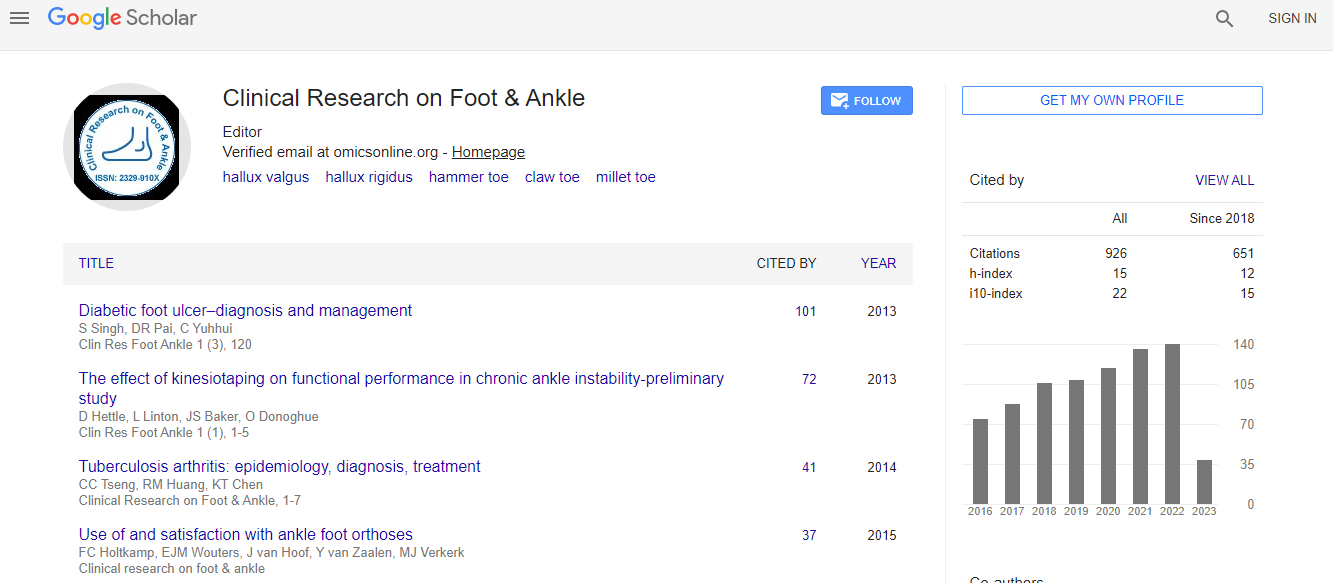Research Article
Prediction of the First Ray Axis from Clinical Measurements: Implications for the Treatment of Bunion
| Glasoe Ward M*, Wolff Kristina, Wicks Andrew, Shaw Andrea and Smith Janie | ||
| Program in Physical Therapy, Medical School, University of Minnesota, Minneapolis, USA | ||
| Corresponding Author : | Glasoe Ward M Program in Physical Therapy, Medical School 420 Delaware St SE, MMC 388, University of Minnesota Minneapolis MN, 55455, USA Tel: 612-624-9894 Fax: 612-625-4274 E-mail: glaso008@umn.edu. |
|
| Received June 12, 2014; Accepted June 20, 2014; Published June 27, 2014 | ||
| Citation: Ward G, Kristina W, Andrew W, Andrea S, Janie S (2014) Prediction of the First Ray Axis from Clinical Measurements: Implications for the Treatment of Bunion. Clin Res Foot Ankle 2:144. doi:10.4172/2329-910X.1000144 | ||
| Copyright: © 2014 Ward GM, et al. This is an open-access article distributed under the terms of the Creative Commons Attribution License, which permits unrestricted use, distribution, and reproduction in any medium, provided the original author and source are credited. | ||
Related article at Pubmed Pubmed  Scholar Google Scholar Google |
||
Abstract
Objective: Inclination of the first ray axis has been identified as a risk factor of bunion, but the actual orientation of a joint axis can only be quantified with motion analysis techniques. This investigation used a single-group regression design for the purpose of identifying a surrogate measure, or system of measurements, that could predict the orientation of the first ray axis.
Methods: The clinical measurements of the foot were performed on 20 women participants including 10 with, and 10 without bunion. Magnetic resonance images of the foot were acquired while the participant stood to simulate gait. Images were then rendered into virtual datasets from which first ray kinematics were decomposed into X, Y, and Z Cardan angles and helical axis direction cosine component parameters. Reliability of the clinical measurements was assessed, and multiple regression analysis determined the relationship amongst variables.
Results: Measurements of dorsum foot height, hallux dorsiflexion, hallux angle, intermetatarsal angle, and arch angle were reliable (ICC ≥ 0.67) and when used as variables in the regression analysis models, the curvilinear measure of hallux dorsiflexion and the linear measure of hallux angle combined to explain a significant (p=0.01) 49 percent (R2=0.49) of the overall variance in predicting the first ray axis.
Conclusion: Five of the clinical measurements, all except navicular drop and hindfoot valgus were judged reliable. Of these, only hallux dorsiflexion and hallux angle had a relationship with the first ray axis. This report marks the first attempt to identify measures that predict the loading behaviors of the first ray. Results may inform future work, as it is likely some other combination of measurements may more strongly predict inclination of the first ray axis which may, in theory, be amendable with non-operative treatment (i.e. orthoses) in the management of foot bunion.

 Spanish
Spanish  Chinese
Chinese  Russian
Russian  German
German  French
French  Japanese
Japanese  Portuguese
Portuguese  Hindi
Hindi 
